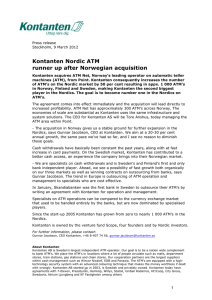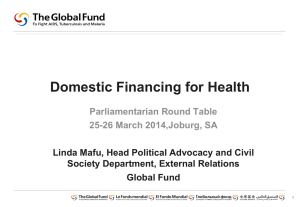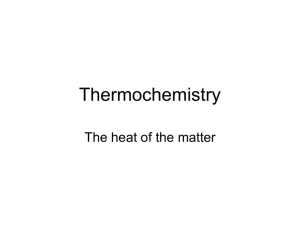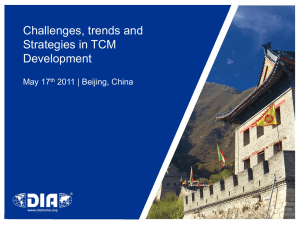Presentation
advertisement
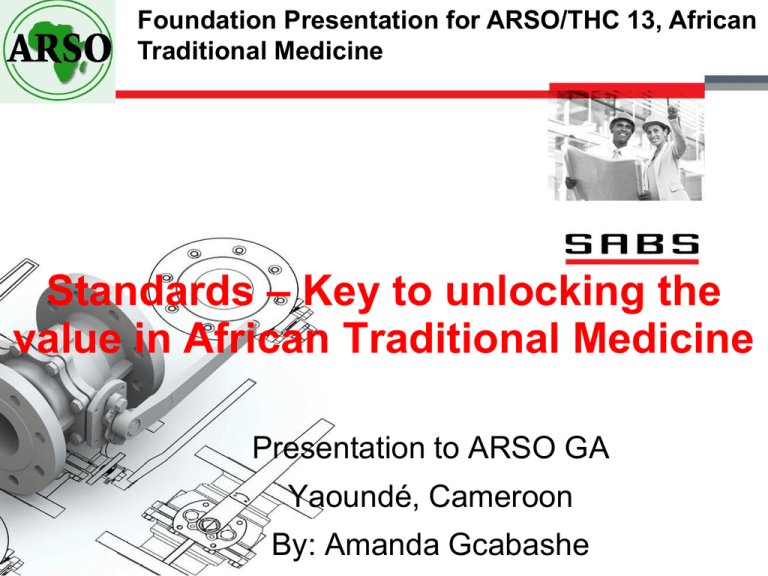
Foundation Presentation for ARSO/THC 13, African Traditional Medicine Standards – Key to unlocking the value in African Traditional Medicine Presentation to ARSO GA Yaoundé, Cameroon By: Amanda Gcabashe Aims of Presentation • Provide an overview of the WHO view of the role of TM in society • Standards and Traditional Medicine – WHO – ISO – SABS • South African Case Study • International benchmarks for developing TM • Standards the key to unlocking the value in ATM Definition of Traditional Medicine “The sum total of the knowledge, skills and practices based on the theories, beliefs, and experiences indigenous to different cultures, whether explicable or not, used in the maintenance of health as well as in the prevention, diagnosis, improvement or treatment of physical and mental illness” WHO estimates 80% of population in Africa depend on TM for their primary healthcare Quote from OECD in 2003 “Culture can be the engine for ECONOMIC, SOCIAL and ENVIRONMENTAL TRANSFORMATION of the space in which we live. Culture is not passive; rather it is one of the fastest growing and most labour intensive industries in advanced nations.” (own emphasis) La culture peut être le moteur de la transformation économique, sociale et environnementale de l'espace dans lequel nous vivons. La culture n'est pas passive, mais plutôt qu'il est l'un des plus rapides industries à forte croissance et le plus de travail dans les pays avancés WHO and TRADITIONAL MEDICINE • Since 1978, with the Alma Ata Declaration, WHO has called for the integration of TM. • WHO Africa declared 2001 – 2010 Decade of TM and has had to declare a 2nd Decade of TM (2011-2020) due to inadequate progress made by member nations. WHO TM Guidelines, 2002-2007 • Minimum requirements of registration of herbal medicines • Technical guidelines for safety, efficacy & quality • Good agricultural and collection practices • Monographs on selected medicinal plants • GMP for herbal medicines • Assessing quality of herbal medicines with reference to contaminants and residues • Consumer information on proper use of TM • Basic training guidelines for providers of TM (focus on TCM modules) ISO and Traditional Medicine • June 2009, ISO TMB established ISO/TC 249 TCM (provisional)- 1st Plenary in June 2010 • 21 countries, 11 observer countries • Africa: Ghana, South Africa and Tunisia • May 2013 – held SADCSTAN Capacity Building Workshop and ATM Conference as part of hosting ISO/TC249 – South African THP’s observers of ISO standardisation SABS and Traditional Medicine • SABS TC1097 African Traditional Medicine held 1st meeting in May 2013 (work began in 2011!) • April 2013 – SADCSTAN established exploratory TC on ATM • Why is the development of ATM in SA @ SABS and not Ministry of Health? Excluded Economic Impact of ATM • In excess of 400 000 employment opportunities • South African ATM industry valued by latest SEDA report at approximately R20 billion per annum – approximately 5% of GDP • Not counted in National Stats because of the “informal” nature of the industry • Despite this phenomenal contribution, not much has changed in the landscape of ATM in South Africa Current ATM Support Structure in SA Main funding for Biotechnology research with small number of knowledge holders Funding for cultivation on limited small scale Interim THP Council Research facilitated by Ministry of Science & Technology. Aim: Novel Drugs from ATM Funded primarily by Ministry of Science & Technology Established by Ministry of Health; focus on regulating Practitioners as per the THP Act TM Sector Support Required • Industrialisation of ATM will naturally lead to biotech industries. • Driver of this is the development of Standards Aim: creation of new ventures and economic opportunities through industrialisation of ATM TM Biotechnology Creation of TM healthcare delivery system Consolidation of practices through self regulation Existing Sector – unregulated and unsupported -dominated by individual practitioners; own clinics & medicines Chinese State Administration of TCM To plan, guide & coordinate TCM structures Formulate & implement technical plans on TCM research Supervise & co-ordinate integration of western and TCM Perform other tasks assigned by the minister of health Guide exploration, summarization & improvement of TCM theories Conduct international exchange & collaboration on TCM Promote and guide the protections of Chinese medicinal plants Give advice on protection of TCM Intangible Cultural Heritage; protect endangered practices Formulate plans & relevant standards Formulate & implement TCM education standards Indian State Administration of AYUSH Improve AYUSH educational standards Protection of India’s Traditional Knowledge Quality control & standardisation of drugs Evolve pharmacopoeial standards for Indian Systems of medicine Improve availability of medicinal plant material Generate awareness of AYUSH efficacy domestically & internationally Schemes for the promotion, cultivation & regeneration of medicinal plants Strengthen & sustain research & development into AYUSH Global Trade in TM Source: SABS Traditional Medicine Intervention Report - Unpublished Globalisation of TM • Global traditional medicine trade in 2010 estimated at US$83 billion o Dominated by western herbal medicine, TCM and Ayurveda o African share of this is insignificant • Herbal medicine is growing at between 10% - 20% p.a. • Revision of WHO ICD11 codes to include TM – but which ones?? WHO TM processes have focused on TCM and Ayurveda Where do we start???? Globalisation of ATM through standards • African wealth in plant biodiversity makes it a bio-prospecting hot spot • ATM has not received the institutional support that is necessary to bring the practice into the 21st century without losing its cultural significance • Traditional medicine is an recognised healthcare option. internationally • Either we support & develop African Traditional Medicine (has consumer base of 800million) or we exclusively adopt other TM – which is it? Globalisation of ATM through standards • ATM is our common heritage • NEPAD/AU Pharmaceutical Strategy speaks about local production of medicines including TM • Inter-regional trade in medicinal plants is reality • Standards for ATM codify indigenous knowledge which leads to protection and preservation • Standards will lead to development of the ATM supply chain which has direct implications for: – Rural job creation through cultivation – New manufacturing industries – Traceable and reliable healthcare system Possible Standards in ATM • Procedures for processing medicinal plants • Packaging and labelling of raw materials • Storage of raw materials • Sustainable harvesting • Good Agricultural and Cultivation practices Possible Standards in ATM • Packaging of ATM remedies • Certification of production facilities • Preparation of ATM remedies • Storage of prepared ATM remedies • Minimum labelling requirements for ATM remedies • Testing of ATM for residues and contaminants Possible Standards in ATM Consumer guidance on how to prepare ATM remedies What can standards achieve? 1912 Market – Picture from K. Flint book titled Healing Traditions Picture of Faraday Market taken in 2012 by Amanda What can standards achieve? Picture of TCM Market, Guangzhou, China. Taken in 2011 Processed medicinal plants (called decoction pieces) ready for use in a herbal decoction at a pharmacy. Picture taken in Incheong, Korea, May 2012 What Can Standards Achieve? Ayurveda Commercial Products TKM Commercial Products What can standards achieve? Documenting of Korean Medicine recognised as a World Heritage by UNESCO Picture taken at KIOM, May 2012 What Can Standards Achieve? Innovations in traditional medicine Chair to facilitate enema (ukuchata) Source: Google Images Electric ceramic pot for boiling herbal medicine What can standards achieve? Exhibition of Traditional Korean Medicine taken at KIOM, May 2012 Summary • Integrated Standards are key for ATM to be recognised as a “Globally Significant” traditional medicine • Process supports the stated aims of the WHO to integrate TM into national healthcare systems • Supports the creation of a new industries in countries: – manufacturing sector on the continent – beneficiation of the “Green Gold” of the continent – Cultural tourism ventures, including Museums and African spas Reclaims the African pride – humanity originates from Africa and so does healing and healthcare THANK YOU
